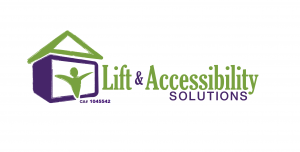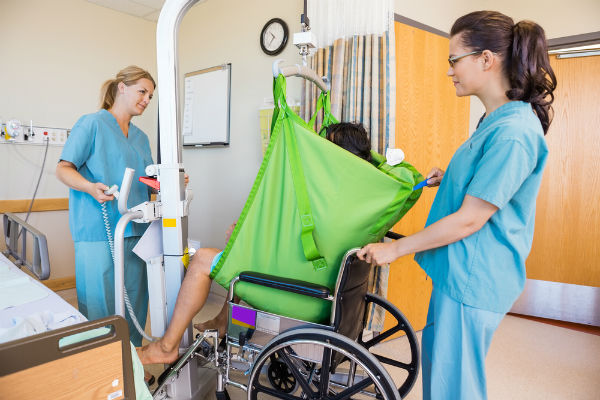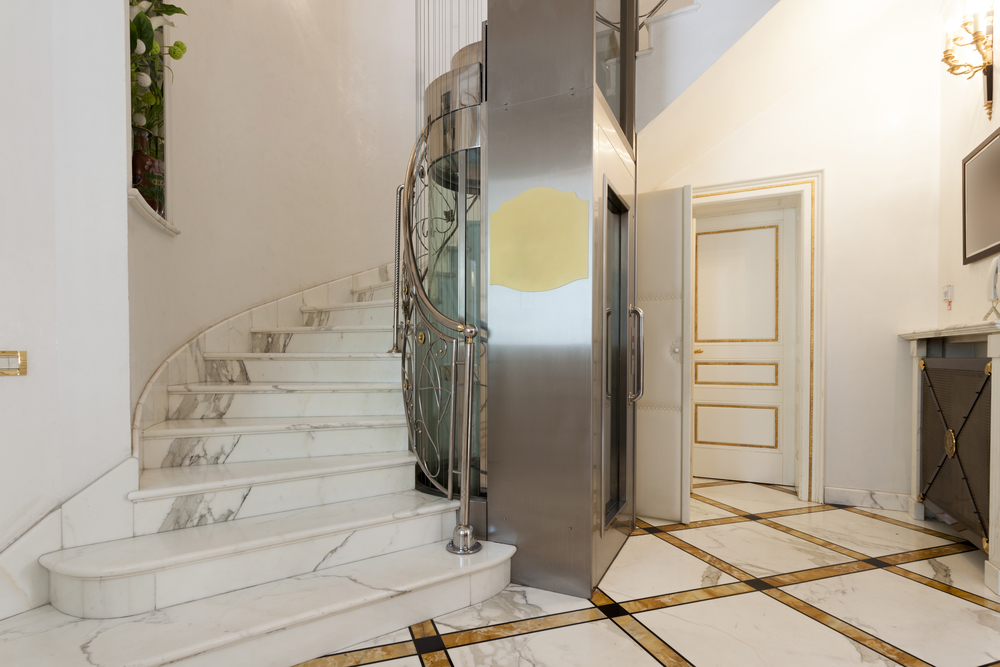As we and our loved ones age, mobility begins to become more of an issue with each passing year. Old injuries, the progress of arthritis, loss of balance, and various other aspects of a normal aging process start to limit what we can do and where we can go, even within our own homes. Persons with physical disabilities may also find that they are unable to move freely throughout their home and need some extra help getting around. For many, installing a lift in their multi story home restores a great deal of their mobility and independence. Let’s take a look at the different types of lifts and how each can help seniors and the disabled regain both their mobility and their freedom to move around their home.
Stairlifts
Quite possibly the most popular accessibility lift option, stair lifts offer many options and features that allow installers to customize them to the individual needs and home of the user. A sturdy rail support with a folding seat is installed on the wall of a staircase leading to the floor to which the user needs easier access. Powered by an electric motor, these lifts allow anyone to sit on the folding seat and ascend or descend the staircase without needing to climb the steps themselves. Stairlifts and accessories can also be matched to the decor of your home without compromising the style or aesthetic as well. Best of all, in addition to being one of the most versatile home accessibility lift options, stairlifts are also among the most economical options, too.
Wheelchair Lifts
While somewhat bulkier than stairlifts, wheelchair lifts offer the ability to make every floor in your home wheelchair accessible. Like a stairlift, wheelchair lifts have a folding platform mounted to a sturdy rail system installed in the wall of the staircase. Users unfold the platform and maneuver their chair onto it, usually securing themselves and their chair via an installed stability bar or similar mechanism. All that remains is a push of the “up” button, and they can be on the second floor independently in seconds. Wheelchair lifts can also be customized to better suit the decor and aesthetics of your home, allowing you to make them less visually obtrusive.
Personal Elevators
For those who have stairways too narrow for stair or wheel chair lifts, personal elevators make an excellent option. These unique lifts do not require a shaft to function, and can be installed directly through floors to reach levels of the home above or below them. These are an exceptionally quiet and safe option for users who use a wheelchair or for whom stair climbing and descent are no longer an option. Personal elevators also allow users to place them more discreetly within their home to keep their interior design and decor intact, too. While they are probably the most efficient option that requires the least amount of home renovation, they can be significantly more expensive than stairlifts or wheelchair lifts.
All in all, no senior or person with physical disabilities need limit their independence due to a loss in mobility. A stairlift, wheelchair lift, or personal elevator restores your personal independence and make every floor of your home easily accessible once again.
28 Jul 2016
Reasons to Consider an Overhead Lift
An overhead lift is a motorized lift that can be used in the home in order to transfer a person from one place to another, or simply be re-positioned with the assistance of an overhead track. These tracks can either be self-standing, making them portable, or they can be mounted on the ceiling of any room throughout the house. A sling is used in order to move the person from place to place or to make themselves more comfortable where they are. The patient is transferred in an up and down motion and can manually be moved from one side to another.
*
After realizing how valuable these lifts were in assisting hospital staffs, they are now available for use at home, although a lot of people in need are unaware of their availability. Ceiling lifts make it possible for patients to be in the comforts of their own home instead of having to spend additional time in either a hospital or after care facility. The strain that is often experienced by a caregiver is greatly reduced with the use of an overhead lift and makes it easier to move the patient from place to place.
*
Because of the fact that specific needs differ from one patient to the next, an assessment should be completed on the person in need before the purchase of an overhead lift to make sure they are getting a model that will be of benefit for their individual purposes. Different makes and models of overhead lifts differ in the capabilities and features that are offered. This need to be taken into consideration in regards to the needs of the patient.
*
The type of sling used with the lift should match the needs of the person it will be used for. You will also want to keep in mind what the lift will be used for when choosing a sling. If the main purpose of the lift is helping the patient readjust or change their position while in bed, you might need the same type of sling intended for helping someone who specifically needs assistance with access to and from a bathroom. This is something you might discuss with a nurse or other health care provider in order to make sure the proper sling is being used.
*
You will want to select an overhead lift model that includes an over speed governor to be sure that the lift is not being raised or lowered at unsafe speeds. An emergency lowering system is another feature that adds to the safety of the lift.
What is the Difference Between Home Elevators and Lifts
If you are interested in installing either an elevator or lift into your home, it is important to spend some time weighing the pros and cons of each. Factors such as cost, capability and ease of install, need to be a part of your decision. Keep these aspects in mind and choose the machine that is right for you.
Lifts
A lift, also known as a platform lift, is a powered device that is designed to raise an occupant, most often in a wheelchair or other assisted device, over a vertical barrier such as a high step or a flight of stairs. They are often installed in homes and businesses and are often found on public transportation vehicles, including public buses and trains as part of the requirements of the Americans with Disabilities Act.
In the home, platform lifts consist of a platform, the lift tower, and the controls needed to operate the device. Lifts can be restrictive in their capabilities as most are limited to around 12 feet of vertical travel. A residence will also need approximately six square feet of space to accommodate the lift. Lifts can be an incredible alternative to a ramp, which can take up much more space and have fewer capabilities
Elevators
Elevators are an alternate option. Residential elevators have the ability to reach at least two floors in your home. The construction involves installing a shaftway, which encloses the cab, and the machinery needed to manipulate elevator.
Elevators are ideal in homes where more than one person will need to access a higher floor simultaneously as elevators are capable of handling much more weight than a lift. The good thing about elevators is that they can be constructed in a variety of designs so they are an excellent choice for multi-floor transport.
Additional differences
If you are thinking of installing an elevator, there are several factors that you will need to understand so that you pick the proper option for your situation. When it comes to cost, lifts generally cost much less than elevators. Elevators also require more construction and equipment than your regular one person lift. On the positive side, elevators can have a sleek appearance and transport multiple individuals at once.
There is a lot of thought that goes into deciding whether an elevator or a lift is the right option for your San Francisco, CA home. Regardless of your choice, know that either option is an excellent fit for almost every home.
19 Jun 2016
5 Reasons To Consider A Residential Elevator
Providing safety and convenience, a residential elevator is an accessible device which assists physically disabled people to move from floor to floor. Elevators are also beneficial for transporting bulky items and groceries. Most importantly, an elevator increases the quality of your lifestyle. Residential or home lifts usually take less space in comparison to stairs, and this option will aid you in saving space for other uses. Elevators require only little room. The elevator can be easily installed outside on an external wall, which would give an indoor entry to the users at every level. Elevators of residences would help in the prevention of accidents. Many times, people fall from stairs and injure themselves severely. To avoid these worse circumstances, elevators could be used by dwellers in their home.
- Functionality and Accessibility: One of the main reasons to install a residential elevator is that it significantly improves the accessibility to the upper levels of your home. This is particularly beneficial if you have older family members living in the home or if you have mobility problems. An elevator can eliminate the risk of falling down the stairs for family members and guests who might otherwise have a hard time climbing a staircase.
- Space-Saving Design: If you’re building a new multi-storied home, an elevator can help you save a considerable amount of space that might otherwise be reserved for a stairwell. In some cases, the elevator can be installed outside the home on an external wall, freeing up even more floor space inside your home for other features you want to include.
- Luxury: Residential elevators are seen as one of the symbols of luxury, which means your home will instantly be the envy of guests, friends, and neighbors after you have a residential elevator installed. And unlike some other status symbols, an elevator is practical and highly functional.
- Improve Safety: One of the most common ways people are hurt in the homes is from the staircase. A home elevator protects not only young children but also adults who are frail. There is virtually no risk to riding your residential elevator as compared to running up and down the stairs.
- Demonstrate Style: Since Marin residential elevators are becoming more affordable and available, many homeowners are looking into them to add a unique look to their property and also increase functionality. It can also help your homes price value by installing an elevator because this is a luxurious add-on.
07 Aug 2015
Stiltz: The Affordable Home Elevator
Life is all about experiences. Many are willing to pay top dollar for the best in all aspects of life. Having the best things in life is a luxury many strive to have. Not all of us are in a position of acquiring luxury items to make our lives easier. Fortunately, you no longer have to be rich or live in a mansion in order to indulge in freedom of mobility. With the Stiltz lift, you can now have your own personal elevator in your home. Stairs are no longer the only option! Serving many homes in Sonoma County, residents are taking advantage of the new experience. After all, who doesn’t want a taste of the finer things in life?
About the company
Stiltz brand is the top company in home elevator installment in Sonoma County. Since their beginnings in 2010, the company has grown to offer their home elevators in various countries, while offering the same quality services and delivering their product all the same. Developed by a team of highly experienced engineers, the first model of Stiltz home elevators offers a unique functionality for a residential product. Particularly in the U.S., a new office was opened in Allentown, PA to meet the high American demand.
How is it installed?
Along with it being a luxurious addition to your home, Stiltz home elevators are installed with ease. Taking as little as two days to install, the self-sufficient appliance will be available for use in your home in no time. Don’t worry about your walls being able to take the load of your elevator as it is self-supporting and won’t need to be affixed to any walls. As far as powering the device goes, it is as simple as plugging the power cord into an outlet. Ironically, Stiltz home elevators actually run on less electricity than many home appliances; high-energy bills will not be a concern.
Can I get one?
With its unique versatility, Stiltz home elevators can be installed in various types of homes. Capable of fitting in small spaces, only seven squares of feet are needed for the elevator to be added to your home. In short, more times than not you will be able to have your own home elevator in the location of your choice. Otherwise, a separate, more suitable location will be suggested to place the elevator in your home. Not to mention, thanks to its mobility and self-sufficiency, it is possible to take your home elevator with you if you choose to move. Such a factor only makes the decision easier to call for a quote!









